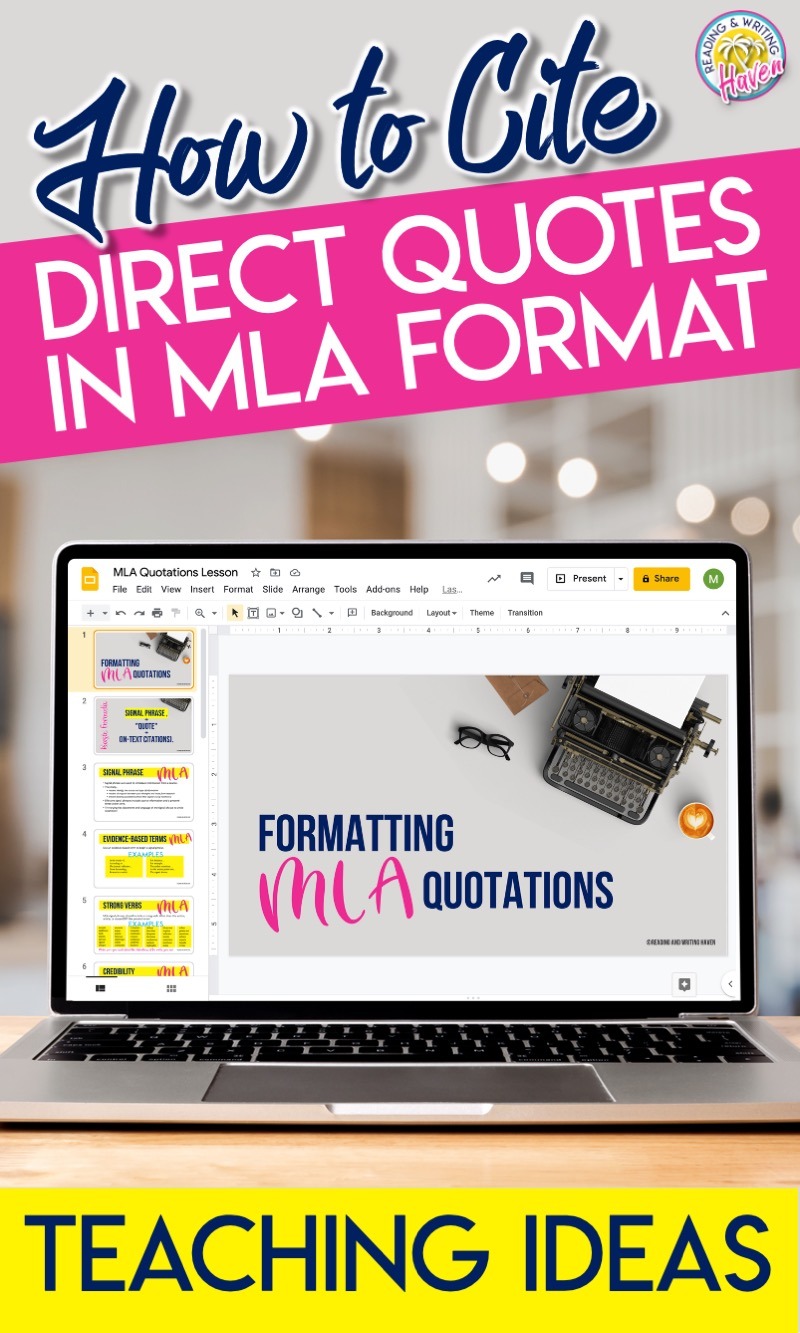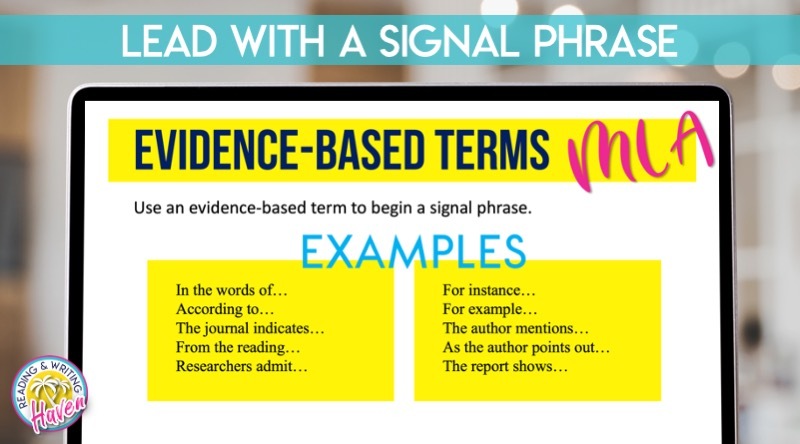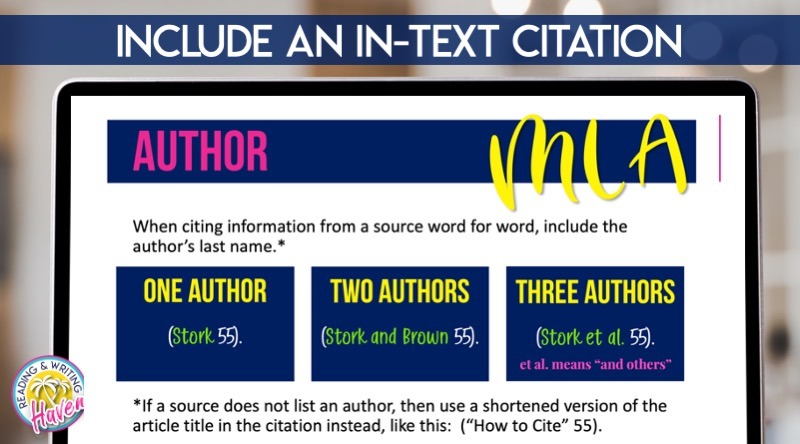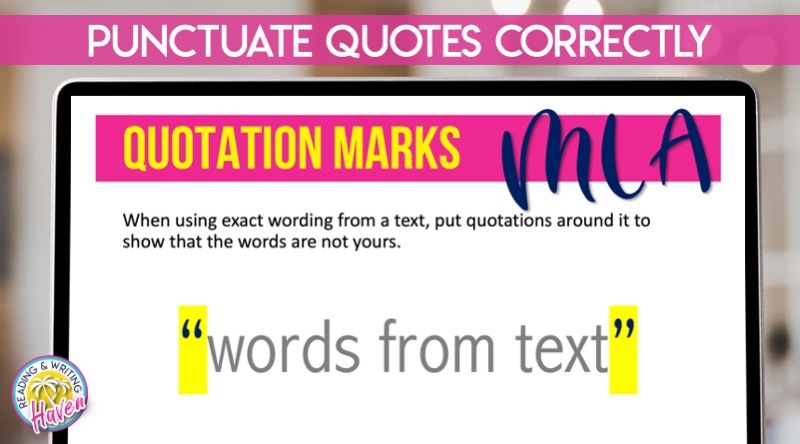How to Cite Quotations in MLA Format: Teaching Ideas
MLA is fussy. When teaching students to cite quotations in MLA format, it can feel like we are really nit-picking at details. And, I suppose we are. Students need to include certain elements, and those elements are really not negotiable.
Assuming students have already chosen relevant evidence to support their claim, they’re ready to put it to action in their writing. This post outlines the process I use to simplify citing text evidence in MLA format. It’s somewhat calculative and predictable, which many students appreciate.
CITING QUOTATIONS IN MLA FORMAT: SCAFFOLDING IDEAS
Instructionally, I always introduce this lesson to the whole class through direct instruction and modeling. Then, I work with small groups of students and one-on-one in conferences to provide targeted feedback.
This post offers some scaffolding ideas. This is how I teach students to cite quotations in MLA format.
SIGNAL OR LEAD-IN PHRASE
Evidence-Based Term
To help the audience follow along, students can introduce a quote with an evidence-based term. These terms alert the audience that writers are going to cite evidence to support their ideas and opinions. Phrases like, According to the author, and As one article from the New York Times reveals, alert the audience that the information to come is from a source outside the author of the paper.
Strong Verb
I encourage students to use a variety of precise verbs in signal phrases. Did the authors of their sources “say” over and over? Or, did they assert, suggest, counter, highlight, and so on? Verbs have connotations, and we can teach students to choose verbs for their precise denotations and associated connotations.
Credibility
The first time students cite a source in their essay, I ask them to establish credibility in the signal phrase. Why should we trust the author of this quote? Explicitly stating who wrote the information assures readers that you are consulting reputable sources. Students can establish credibility by speaking to the reputation of the author, the source, or both.
- NASA scientist Ellen Stofan recommends, “…”
- As Harvard Journal of Law and Technology researcher Peter Menell explains in a recent article, “…”
- Recent research, such as the Pew Research Center’s 2017 study finding, indicates, “…”
Students often ask, “If I am citing the same source twice in this paragraph, and the sentences are close together, but my elaboration is between them, do I need to establish the credibility again?” In this case, they can write something like, “In the same article,” “The same author / source explains…”, or “The same article proceeds…”
When students cite the same source later in the paper, I ask them to refer to it more briefly than they did at first. Consider…
- Scientist Stofan recommends, “…”
- Harvard journalist Peter Menell explains, “…”
- The 2017 Pew Research study shows, “…”
PARENTHETICAL CITATION
Sentences that contain quoted research need to end with an internal citation. MLA format requires both the author’s name and the page number of the source to be included in the in-text citation. However, the page number should always appear in parenthesis, not in the text of the sentence.
Let’s look at examples:
- Counselor and teacher Gary Chapman writes, “For a child to feel love, we must learn to speak his or her unique love language” (20). Here, the author’s name is included in the signal phrase, but the page number is in the citation.
- Proactive parents understand that “For a child to feel love, we must learn to speak his or her unique love language” (Chapman 20). Here, both the author’s name and the page number are in the citation.
If a source has no author, MLA requires students to use a (shortened) version of the title of the article. For instance, a source called “Fashion Trends of the 1920s” could look like this: (“Fashion Trends”). If a source has no page number, students should not substitute printer page numbers. I tell students to simply omit it.
In-text citations can get messy! When students are citing sources with multiple authors, citing quotes within a quote, or citing newer, non-print sources, I refer them to Purdue Owl’s style guide. I want students to know how to find their own answers to citation questions.
Always, make sure that when a citation ends a sentence, students know to put the period after the parenthetical citation, not before.
Citation Generators
Yes, citation generators abound! I don’t mind if students use them, but I prefer to teach them how to cite formally from scratch first. How will students be able to double-check what a citation generator produces if they haven’t first learned the basics of citations? Generators are helpful with expediting the process once students have a basic understanding of how to write them independently.
PUNCTUATING THE QUOTE
Punctuation is like the crown molding of cited research. Polishing the sentence off with well-used punctuation marks adds clarity and professionalism. Other than parenthesis, there are three important punctuation marks to include if you are going to cite quotations in MLA format.
Comma
Students should use a comma after a signal phrase before the quotation.
- Albert Einstein once asked, “If we knew what it was we were doing, it would not be called research, would it?”
But, there is a small exception! When using the word that at the end of the signal phrase, the comma is omitted. I practice this with students.
- Albert Einstein once said that “If we knew what it was we were doing, it would not be called research, would it?”
When beginning a sentence with a quotation, the order is mirrored.
- “If we knew what it was we were doing, it would not be called research, would it?” Albert Einstein once asked.
Quotations
Quotations are essential in sentences that are cited word-for-word from research. It’s important to teach students that using quotation marks is a priority. We talk about how leaving them out is a type of plagiarism. Students either need to use quotations or completely paraphrase the information.
The most confusing part of quotations for students seems to be whether the comma goes inside or outside. Simplify with a visual.
- signal phrase , “quote“ (citation).
- “quote , “ signal phrase (citation).
Ellipses and Brackets
Sometimes, students need to add a word (or a few) to a quotation so that it makes more sense to the reader. When doing so, students need to put brackets around the words they are adding.
- Science Focus Magazine warns, “These tricks [on social media] are borrowed straight from casinos and slot machines, which are widely considered to be some of the most addictive machines ever invented” (“Trapped”).
Other times, students want to omit words from a quote to help flow and clarity. In this case, students should use three consecutive periods to indicate a word or phrase has been removed.
- Science Focus Magazine warns, “These tricks [on social media] are borrowed straight from casinos and slot machines, … some of the most addictive machines ever invented” (“Trapped”).
Make sure that you remind students that any time they use brackets or ellipses, their additions and deletions should not change the meaning of the sentence. And, an ellipses should not create an awkward, incomplete thought.
Note…when teaching students to use brackets, quotations, and parenthesis, be ready for them to confuse the three! An easy way to address this misconception is by using a visual of the punctuation mark you are referring to. I recommend writing it on the board as you talk about it.
OTHER SCAFFOLDING IDEAS
While there are some variations, I introduce a basic formula for quoting research.
- signal phrase , + “quote” + (in-text citation).
- “quote , ” + signal phrase + (in-text citation).
This is a whole-class lesson, but teaching students to cite quotations in MLA format is a multi-step process in my classroom. Specifically, following up with one-on-one conferences and targeted small group feedback results in the biggest learning gains!
My students have also benefited from white board practice and color coding each part of a direct quote.
It took me many years to feel like MLA and I were friends. I hope this post has given you some insider’s tips, saved you some time, and brought you closer together with this high-maintenance citation style.
RELATED READING:
Teaching Elaboration in Writing
Using Body Paragraph Examples to Strengthen Writing



